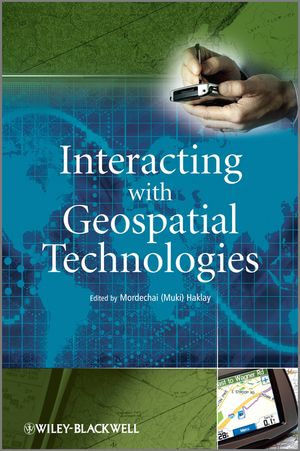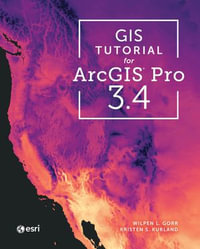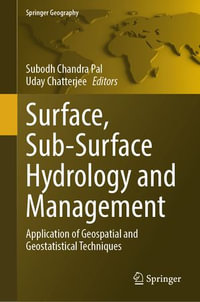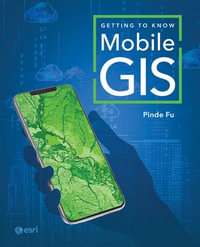
Interacting with Geospatial Technologies
eText | 26 October 2015 | Edition Number 1
At a Glance
eText
$171.59
or 4 interest-free payments of $42.90 with
orInstant online reading in your Booktopia eTextbook Library *
Read online on
Not downloadable to your eReader or an app
Why choose an eTextbook?
Instant Access *
Purchase and read your book immediately
Read Aloud
Listen and follow along as Bookshelf reads to you
Study Tools
Built-in study tools like highlights and more
* eTextbooks are not downloadable to your eReader or an app and can be accessed via web browsers only. You must be connected to the internet and have no technical issues with your device or browser that could prevent the eTextbook from operating.
This book provides an introduction to HCI and usability aspects of Geographical Information Systems and Science. Its aim is to introduce the principles of Human-Computer Interaction (HCI); to discuss the special usability aspects of GIS which designers and developers need to take into account when developing such systems; and to offer a set of tried and tested frameworks, matrices and techniques that can be used within GIS projects.
Geographical Information Systems and other applications of computerised mapping have gained popularity in recent years. Today, computer-based maps are common on the World Wide Web, mobile phones, satellite navigation systems and in various desktop computing packages. The more sophisticated packages that allow the manipulation and analysis of geographical information are used in location decisions of new businesses, for public service delivery for planning decisions by local and central government. Many more applications exist and some estimate the number of people across the world that are using GIS in their daily work at several millions. However, many applications of GIS are hard to learn and to master. This is understandable, as until quite recently, the main focus of software vendors in the area of GIS was on the delivery of basic functionality and development of methods to present and manipulate geographical information using the available computing resources. As a result, little attention was paid to usability aspects of GIS. This is evident in many public and private systems where the terminology, conceptual design and structure are all centred around the engineering of GIS and not on the needs and concepts that are familiar to the user.
This book covers a range of topics from the cognitive models of geographical representation, to interface design. It will provide the reader with frameworks and techniques that can be used and description of case studies in which these techniques have been used for computer mapping application.
Read online on
About the authors.
How to use this book.
Acknowledgements.
SECTION I THEORY.
1 Human-computer interaction and geospatial technologies - context Mordechai (Muki) Haklay and Artemis Skarlatidou).
1.1 Human-computer interaction and usability engineering background.
1.2 Geographic Information Systems and science history.
1.3 Human-Computer Interaction and GIScience research.
Summary.
Further reading.
Revision questions.
2 Human understanding of space (Clare Davies, Chao (Lily) Li and Jochen Albrecht).
2.1 Introduction.
2.2 Spatial cognition: screen versus geography.
2.3 Geographic spatial cognition - learning, understanding and recall.
2.4 GIS in the outside environment: matching maps to geography.
Summary.
Further reading.
Revision questions.
3 Cartographic theory and principles (Catherine (Kate) Emma Jones).
3.1 Principles of cartographic representation.
3.2 Impact of projections on map design.
3.3 Impact of cartographic scale on map design.
3.4 Generalization.
Summary.
Further reading.
Revision questions.
4 Computer-mediated communication, collaboration and groupware (Mordechai (Muki) Haklay).
4.1 Computer-mediated communication.
4.2 Social dynamics and group decision-making issues.
4.3 Computer Supported Collaborative Work and Groupware (CSCW).
4.4 Principles of collaborative GIS.
Summary.
Further reading.
Revision questions.
SECTION II FRAMEWORK.
5 User-centred design (Mordechai (Muki) Haklay and Annu-Maaria Nivala).
5.1 Background.
5.2 Principles.
5.3 Applying user-centred design in geospatial technologies.
5.4 Participatory design.
Summary.
Further reading.
Revision questions.
6 Usability engineering (Mordechai (Muki) Haklay, Artemis Skarlatidou and Carolina Tobon).
6.1 Background.
6.2 Usability engineering and product development process.
6.3 Understanding user requirements and needs.
6.4 Application development.
6.5 Evaluation and deployment.
6.6 Usability engineering in research.
Summary.
Further reading.
Revision questions.
SECTION III PRACTICALITIES AND TECHNIQUE.
7 Application planning (Jochen Albrecht and Clare Davies).
7.1 GIS interface complexity.
7.2 Task analysis in GIS.
7.3 Formalized analysis of GIS user interfaces.
7.4 User experience considerations.
7.5 Task analysis as the basis for workflow management.
7.6 Geo-scientific workflows and process models.
7.7 Ontologies in support of application planning for the semantic web.
Summary.
Further reading.
Revision questions.
8 Practical cartography (Catherine (Kate) Emma Jones).
8.1 The role of symbology in map making.
8.2 The role of colour in map making.
8.3 Data classification - types of maps and thematic mapping.
8.4 Mapping conventions - map elements and layout.
Summary.
Further reading.
Revision questions.
9 Principles of interaction (Jessica Wardlaw).
9.1 Key elements of the theory of interaction for geospatial technologies.
9.2 Basic elements of GUI.
9.3 Some guidelines for designing a GIS interface.
Summary.
Revision questions.
10 Evaluation and deployment (Stephanie Larissa Marsh and Mordechai (Muki) Haklay).
10.1 Evaluation options - from usability laboratory to guerrilla usability.
10.2 Evaluation techniques.
10.3 Methodological consideration of usability techniques.
Summary.
Further reading.
Revision questions.
11 Single user environments: desktop to mobile (Mordechai (Muki) Haklay and (Lily) Chao Li).
11.1 Technological considerations.
11.2 Understanding the user context.
11.3 Designing desktop applications.
11.4 Mobile devices.
Summary.
Further reading.
Revision questions.
12 Web-mapping applications and HCI considerations for their design (Artemis Skarlatidou).
12.1 Overview of Web-mapping.
12.2 Web-mapping design and HCI considerations.
Summary.
Further reading.
Revision questions.
Bibliography.
Index.
ISBN: 9781119219248
ISBN-10: 1119219248
Published: 26th October 2015
Format: PDF
Language: English
Audience: Professional and Scholarly
Publisher: Wiley Global Research (STMS)
Country of Publication: GB
Edition Number: 1























